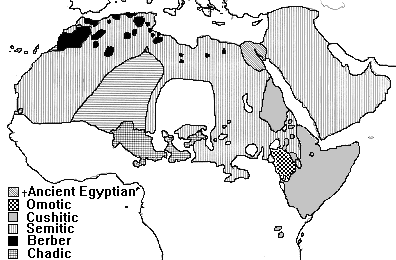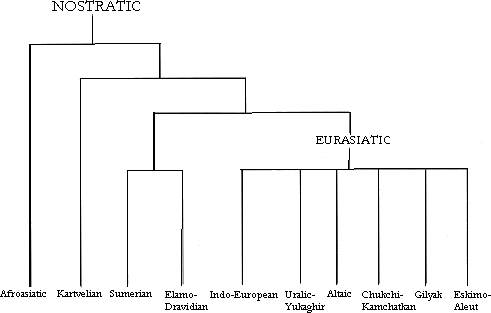|
A Description of the Afro-Asiatic (Hamito-Semitic) Language Family
Cory D. Crawford In contrast to the Indo-European Language Family, about which much research has been done over the past two centuries, relatively little is known about the former Hamito-Semitic Language Family, now known as the Afro-Asiatic Family. (hile much research has been accomplished with the Semitic Languages because of Arabic and Hebraic religious ties, little has been done with the Afro-Asiatic family as a whole.) This paper will describe this language family as is current with modern scholarly thought, and will also acknowledge current research having to do with the Afro-Asiatic Family. This family spreads itself over the northern third of Africa and into western Asia (also known as the Near East), and 175 million people speak languages that belong to this family (Ruhlen 1987:86). It is thought to be the parent of at least 250 languages (Bomhard and Kearns 1994:24). The name Hamito-Semitic was applied to describe the two main phyla (Hamitic and Semitic) that philologists of African languages connected in the late nineteenth and early twentieth centuries. The Hamitic branch included Ancient Egyptian (an extinct language known as Coptic in its final stages), Berber, and Cushitic, while the Semitic branch included the well-documented Arabic, Hebrew, and Akkadian. (More will be said about these phyla shortly.) In 1949 American linguist Joseph H. Greenberg drew different lines in Afro-Asiatic classification. He showed that the Hamitic languages did not bear enough resemblance to be classified as one subgroup, but that each of the three (Egyptian, Berber, and Cushitic) constituted its own subgroup. Thus the name ‘Hamitic’ was no longer valid and possibly racist (Ruhlen 1987:82). He therefore coined "Afro-Asiatic" as the name for this family. It included the six groups Ancient Egyptian, Omotic, Cushitic, Semitic, Berber, and Chadic, found on the following map: 
Fig. 1 Afro-Asiatic Language Family. Adapted from Ruhlen 1987.Bomhard postulates that from Proto-Afroasiatic (henceforth PAA), Chadic was the first to break off. Omotic and Cushitic followed the example and split together, as did Egyptian, Berber, and Semitic in another group. Next, Egyptian followed by Berber split from the Semitic languages (Bomhard and Kearns 1994:24). Before we seek to describe each subgroup, we will describe their mother, PAA. 1. Proto-Afroasiatic Relatively little has been discovered with regards to the detail of PAA. Bomhard and Kerns say that "it is simply not possible, given the present level of knowledge, to reconstruct the morphological structure of the parent language in detail, though some common features have been noted" (1994:24). They also posit that it was highly inflected. Some interesting work is being done now in drawing connections between Proto-Indo-European (PIE) and PAA. Bomhard revised the phonemes of PIE to correlate with PAA, and drew some interesting connections. The following table is an example of this work and shows some similarities between the phonemes of the two languages: (For a more complete example see Bomhard 1984:181.)
Table 1. PAA/PIE CORRESPONDENCES. Adapted from Bomhard 1984:181.An even more interesting connection between PIE and PAA is Bomhard’s 318 "Proto" roots. According to the above revised version of the phonetic constituents, Bomhard found 318 roots of both proto-languages that had almost exact correspondence in both sound and meaning. This is some of the evidence that leads him to conclude that Indo-European and Afroasiatic bear a stronger affinity, both in their phonological systems and in their vocabularies, than could possibly have been produced by accident–so strong, indeed, that no linguist could examine them without believing them to have sprung from a common source. (1984:2) Bomhard draws the following tree structure for the Nostratic family, or the family from whence PIE and PAA derive: 
Fig. 2. The Nostratic Macrofamily. Adapted from Bomhard 1994:36.Having looked at some of the characteristics of Proto-Afroasiatic, it is now appropriate to briefly describe some characteristics of each of its daughters: Egyptian, Omotic, Cushitic, Semitic, Berber, and Chadic. 2. Egyptian The major language that falls under Ancient Egyptian is Egyptian and Coptic. This great language of antiquity experienced its final days in the seventeenth century as a result, in part, of Muslim invasions. It was spoken in the area of modern-day Egypt. The earliest records in Egyptian are in the form of inscriptions dating from 3400 BCE. 3. Omotic Bomhard lists the major languages of Omotic as Dizi, Gimira, Janjero, Kefa, and Walamo (1984:4) (For a more detailed listing of the languages of each phylum, see the Summer Institute of Linguistic's Web site Ethnologue at http://www.sil.org/ethnologue/families/Afro-Asiatic.html.). There are over three dozen total languages pertaining to this phylum, yet Omotic makes up only about one million of the 175 million speakers of Afro-Asiatic languages (Ruhlen 1987:87). The Omotic languages are spoken mainly in western Ethiopia and northern Kenya. Omotic was first proposed to be its own separate phylum in 1969 by Harold C. Fleming. It was previously classified as western Cushitic, and the present classification, while the most widely accepted, is by no means definitive. 4. Cushitic The major languages of Cushitic are, (again according to Bomhard 1984:4), Afar, Agaw, Alagwa, Arbore, Asa, Awngi, Baiso, Beja, Bilin, Born, Burji, Burunge, Dahalo, Dasenech, Dullay, Galab, Gidole, Gollango, Gorowa, Hadiyya, Iraqw, Kambata, Konso, Kw’adza, Ma’a, Oromo, Rendille, Saho, Sidamo, Somali, and Yaaku. These languages are spoken by an estimated 12 million people in the Sudan, Ethiopia, Kenya, Somalia, and Tanzania. The most prevalent of the above languages appears to be Oromo, boasting 7 million speakers. As stated earlier, Cushitic was originally classified under the Hamitic family, but Greenberg showed that it belonged to its own family. It is interesting to note that Cushitic was named for Cush, the biblical name of the son of Ham. Also interesting is that, as Katzner observes, "Somali is the only Cushitic language with a formal system of writing" (1975:32). 5. Semitic The Semitic phylum contains some of the most well-known languages to those in western cultures: Hebrew, Arabic, Akkadian, Phoenician, Syriac, and Ugaritic. Others include Amharic, Eblaite, ESA, Ethiopic, Gurage, Harari, Harsusi, Lihyanite, Nehri, Moabite, Punic, Sheri, Soqotri, Tamudic, Tigre, and Tigriña. The Semitic languages are spoken in much of northern Africa and the Near East (see Fig. 1.). It has the most speakers of any of the phyla, in large part due to Muslim conquests of the seventh century (Bomhard 1994:24). Arabic alone has about 100 million speakers. Altogether the 20 or so languages that comprise the Semitic family report around 120 million speakers. An interesting characteristic of Semitic languages is their tie to liturgy. This has accounted for the preservation of ancient records, the oldest of which, written in Akkadian, can be traced back some 5000 years. The Phonecian language, also (as above noted) a member of the Semitic family, is the source of the alphabetical system used in most of the world today. Hebrew and Arabic are also some of the most well-documented of the Semitic languages and of the Afro-Asiatic family. 6. Berber The Berber languages include Kabyle, Shilha, Sous, Tamazight, Tashelhit, and Tuareg. These languages closely resemble each other, and there has been a postulation of a single Berber language (Katzner 1975:32). There are roughly 11 million speakers of this family, mostly residing in Morocco and Algeria, with other pockets of speakers in Tunisia, Libya, Mauritania, and Senegal. These tongues were also suppressed by the Muslim invasion beginning in the seventh century, and today most speakers fluent in Berber languages also speak Arabic. There is no extant evidence of a Berber alphabet. 7. Chadic This phylum has possibly had the most difficult entrance into the Afro-Asiatic family. One theory that Greenberg had to dispel was that if peoples had different physiological characteristics (skin color, hair type, etc.) then it naturally follows that they also had a different language (Ruhlen 1987:82). There was also a racial motivation for excluding Chadic languages from Hamito-Semitic. As Ruhlen notes, For scholars who fervently believed in the superiority of the ‘white race’, white languages, and the like, the idea of a black branch (Chadic) in a white family (Hamito-Semitic) was disconcerting, if not repugnant. (1987:88) Greenberg was able to show the irrelevance of physiological evidence for linguistic comparison, and showed that Chadic belonged to the Afro-Asiatic family. Chadic includes Angas, Bole, Bura, Dangaleat, Ga’anda, Goemai, Hausa, Higi, Kotoko, Margi, Masa, Musgu, Ngizim, Sayanci, Tera, and Warji as its major languages, with 125 total languages. They are spoken by 12 million people in Chad, Niger, Nigeria, Cameroon, and the Central African Republic. Hausa accounts for at least 80 percent of Chadic speakers. This paper has been a brief outline of the Afro-Asiatic family of languages and some of the problems associated with its classification. We have seen some of the characteristics of the language groups that comprise the Afro-Asiatic family of languages. We have also glanced at some of the research that is being presently conducted by linguists (such as Bomhard) in describing Proto-Afroasiatic. We see the great value of the preservation of ancient records (or of a writing system in general) in the desire to have more solid evidence of familial connections between languages. References Bomhard, Allan R. 1984. Toward Proto-Nostratic: A new approach to the comparison of Proto-Indo-European and Proto-Afroasiatic. Amsterdam: John Benjamins Publishing Company. Bomhard, Allan R. and John C. Kearns. 1994. The Nostratic Macrofamily: A Study in Distant Linguistic Relationship. Berlin: Mouton de Gruyter. Katzner, Kenneth. 1975. The Languages of the World. New York: Funk and Wagnalls. Ruhlen, Merritt. 1987. A Guide to the World's Languages 1. Stanford: Stanford UP. |